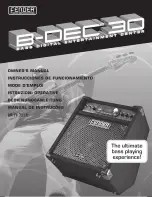
OWNER’S MANUAL
Troubleshooting
Problem
Possible Cause(s)
Solution
Power LED off
No (or poor) power, remote or
ground connections
Blown fuse
Verify connections both at amplifier and
at other ends
Replace Fuse
No Output
(Power LED on)
Speakers not connected
Gain down on either amplifier
or source unit
Speaker(s) blown
Faulty RCA leads
Verify speaker connections at amplifier,
and also at the speakers
Verify gain/eq controls
Disconnect speakers one at a time to
pinpoint defective speaker
Replace RCA leads
No Output
(Protect LED on)
Amplifier is overheated
Vehicle’s battery is supplying
something other than 12V
Review mounting position and conditions
Check vehicle’s battery and charging
system
Distorted output
Source unit/amplifier gain set
too high
Source unit is not capable of
good audio reproduction
Speaker(s) blown
Re-calibrate amplifier with source unit
Replace/upgrade source unit
Disconnect speakers one at a time to
pinpoint defective speaker
Bass is weak
Dual voice coils on subwoofer
wired out of phase
Bad speaker connections
Subwoofers connected out of
phase
Eq settings are reducing bass
power
Poor quality subwoofer(s)
Enclosure too small for
subwoofer
Try swapping over + and – on one of the
voice coil connections
Check speaker connections at subwoofer
and amplifier ends
Check the + and – connections all match,
swap to test
Verify all eq settings on amplifier and
source unit, especially “subsonic” and
“LPF” settings on amplifier
Use TL-1121 subwoofer(s)
Increase enclosure size
Blowing fuses
Excessive output levels
Lower gain
Amplifier switches
on and off
No (or poor) power, remote or
ground connections
Low voltage from battery
Verify connections both at amplifier and
at other ends
Test battery, replace if necessary
If your amplifier is still not functioning correctly after checking through the
“troubleshooting” section, please contact our support team at:
Safety
Health Warning
The Competition Pro range of car audio is built for very high power handling. Listening to
music at such high powers is potentially capable of causing physical side effects such as
nausea or even permanent side effects such as hearing loss. It is therefore absolutely
essential that conservatism and a high sense of judgement are observed when in
operation.
TheLoudest.com accepts no liability for hearing disorders, nausea or other side effects
caused by this equipment.
General Safety
Playing loud music in a vehicle can hinder your sense of what is going on around you on
the road, including your ability to hear your own, and other vehicles. We recommend
listening at low or moderate levels while driving.
TheLoudest.com accepts no liability for injury, property damage or otherwise resulting
from the use or misuse of this equipment.
Do not use any chemicals when cleaning this equipment. Please use a clean dry cloth.
Do not install this unit outside the car, or anywhere where it could become damp or humid,
or where it can become exposed to the sun. It should be installed in a dry and ventilated
area inside the car.
Never connect or disconnect speakers when the amplifier is on; this can permanently
damage the speakers. Always do this when it is off.
Never open the amplifier up. Doing so would put you at risk of an electric shock. None of
the internal parts are serviceable by the user. In the case of the unit needing repair or
maintenance, please take it to a qualified professional.
For both amplifiers, the power, ground and remote connections are all installed as usual.
One amplifier is named the master. This amplifier receives signal in the form of an RCA
lead from the source unit. A single RCA lead is then used to connect the “bridge out” of
the master amplifier to the “bridge in” of the slave amplifier. All settings the user applies
to the master amplifier will automatically be sent to the slave amplifier, so there is no need
to change any settings on the slave amplifier.
When connecting the subwoofer(s), connect the negative speaker terminals of the two
amplifiers together, then the positive terminal of the master amplifier acts as a positive,
and the positive terminal of the slave amplifier acts as a negative. The minimum load
when using two TL-1023 amplifiers together in bridge is 2 ohm.
It is advisable to use two TL-1191 wiring kits for installing two TL-1023 amplifiers.
OWNER’S MANUAL
























